The End is a role-playing game published by Scapegoat Games in 1995.
Contents

The End is a role-playing game published by Scapegoat Games in 1995.

The End, designed by Joseph Donka, Dan Woodward and Reid San Filippo [1] is a self-described "theological horror" role-playing game that uses traditional Christian apocalyptic symbology in an irreverent setting based on the biblical apocalypse. [2] Players take on the roles of characters who have either ended up in Heaven or in Hell following Armageddon. [1]
For character generation, the game employs rules for character abilities and skills similar to Dungeons & Dragons . [1]
The irreverent use of Christian symbols and terminology resulted in some controversy. In the 2014 book Designers & Dragons: The '90s, Shannon Appelcine recalled that the game was banned at Gencon — then owned by TSR, Inc. — which "resulted in Scapegoat staff marching outside Gen Con with placards saying 'The End Is HERE!,' offering another example of censorship being the best marketing." [3] : 83
In the September 1997 edition of Dragon (Issue #239), Rick Swan noted that "If we gave points here at Review Central for irreverence, this over-the-top RPG of 'theological horror' would score a perfect 10." But Swan had some reservations. "Is it fun? Let me put it this way: after an afternoon of End-inspired fun, it took an evening of Barney reruns to restore my spiritual balance." Swan concluded that there might be an audience for the game, saying, "Recommended for the courageous, the broad-minded, and those comfortable with sentences like: 'Q: Is there any kind of afterlife for the Meek? A: No. After life, you rot.'" [1]

The Whispering Vault is a horror-themed role-playing game originally published in 1993. Players take on the role of "Stalkers", persons who have risen above their own mortality to act as servants of the guardians of Reality, tracking down and apprehending rogue gods who have invaded Reality and returning them to the realm of the Unseen where they are cast into The Whispering Vault.
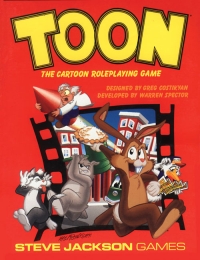
Toon is a comedy tabletop role-playing game in which the players take the roles of cartoon characters. It is subtitled The Cartoon Roleplaying Game. Toon was designed by Greg Costikyan and developed by Warren Spector, and first published in 1984 by Steve Jackson Games.

Empire of the Petal Throne is a fantasy role-playing game designed by M. A. R. Barker, based on his Tékumel fictional universe. It was self-published in 1974, then published by TSR, Inc. in 1975. It was one of the first tabletop role-playing games, along with Dungeons & Dragons, and was the first published RPG game setting. Over the subsequent thirty years, several new games were published based on the Tékumel setting; however, to date, none have met with commercial success. While published as fantasy, the game is sometimes classified as science fantasy or, debatably, as science fiction.
Cthulhu Live is a live-action roleplaying game (LARP) version of the popular horror roleplaying game Call of Cthulhu, based on the works of horror author H. P. Lovecraft.

The Dungeons & Dragons Rules Cyclopedia is a 1991 book published by TSR, Inc., as a continuation of the basic edition of the Dungeons & Dragons fantasy role-playing game, which ran concurrently with Advanced Dungeons & Dragons. Its product designation was TSR 1071.
Teeuwynn Woodruff was an American writer and game designer who worked primarily on role-playing games, television writing and interviewing, and trading card games.

Aria Worlds is a supplement published by Last Unicorn Games in 1994 for use with the role-playing game Aria: Canticle of the Monomyth.

Dangerous Prey is a supplement published by Pariah Press in 1995 for the horror role-playing game The Whispering Vault.
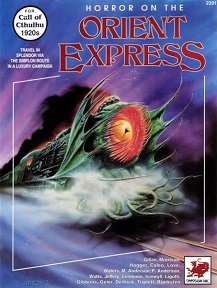
Horror on the Orient Express is a campaign boxed set published by Chaosium in 1991 for the horror role-playing game Call of Cthulhu. In this adventure, the player characters use the Orient Express to search for pieces of an artifact, while a cult tries to stop them. The original edition won two Origins Awards and received positive reviews in game periodicals including The Unspeakable Oath, White Wolf, and Dragon. A revised and expanded edition was published in 2014, which won three ENnie Awards.

GURPS Vampire: The Masquerade is a licensed adaptation of White Wolf Publishing's horror role-playing game Vampire: The Masquerade. It was written by Jeff Koke, and published by Steve Jackson Games in 1993 for the third edition of their GURPS rules.
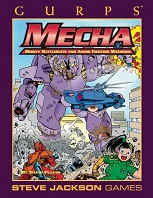
GURPS Mecha is a supplement by David Pulver, published by Steve Jackson Games (SJG) in 1997 for GURPS.
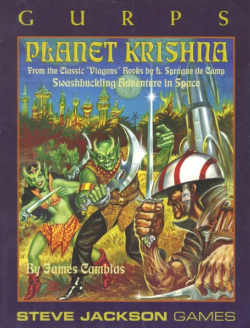
GURPS Planet Krishna is a role-playing game supplement published by Steve Jackson Games (SJG) in 1997 that helps a gamemaster design a GURPS campaign using the Viagens Interplanetarias science fiction setting of L. Sprague de Camp.

GURPS Psionics is a supplement by David Pulver, published by Steve Jackson Games in 1991 for GURPS.

GURPS Robots is a supplement for GURPS. Written by David Pulver, it was published by Steve Jackson Games in 1995.
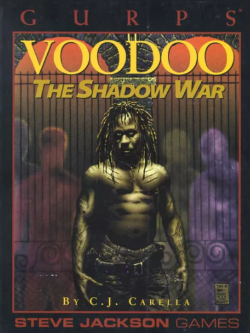
GURPS Voodoo: The Shadow War is a role-playing game supplement by C. J. Carella, published by Steve Jackson Games in 1995, about using voodoo magic in a GURPS campaign.

GURPS Werewolf: The Apocalypse is a supplement published by Steve Jackson Games (SJG) in 1993 that translates the role-playing game Werewolf: The Apocalypse to the GURPS rules set.

Houses of Hermes is a supplement published by Wizards of the Coast in 1994 for the third edition of the fantasy role-playing game Ars Magica.

Theatrix Ironwood is a supplement published by Backstage Press in 1994 for the diceless role-playing game Theatrix.

Killer Crosshairs, subtitled "What Gun Control Was Meant To Be!", is the first product published by Biohazard Games, a role-playing game supplement released in 1995.

The Kingdoms of Kalamar is a fantasy role-playing game campaign setting published by Kenzer & Company in 1994 that is compatible with the second edition of Advanced Dungeons & Dragons published by TSR. Several other editions of the game were subsequently released as new editions of Dungeons & Dragons were published.